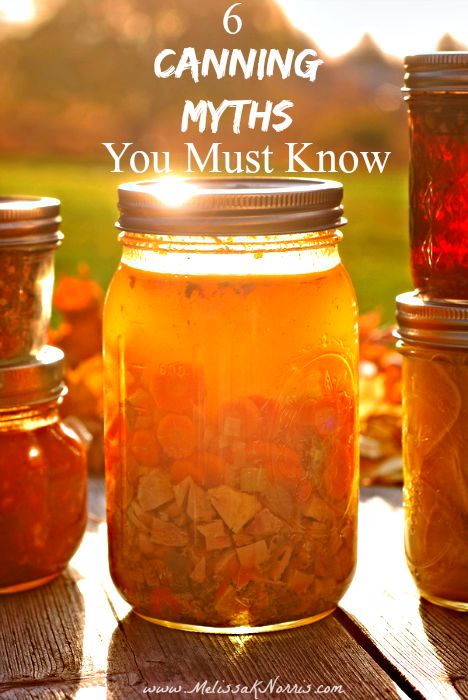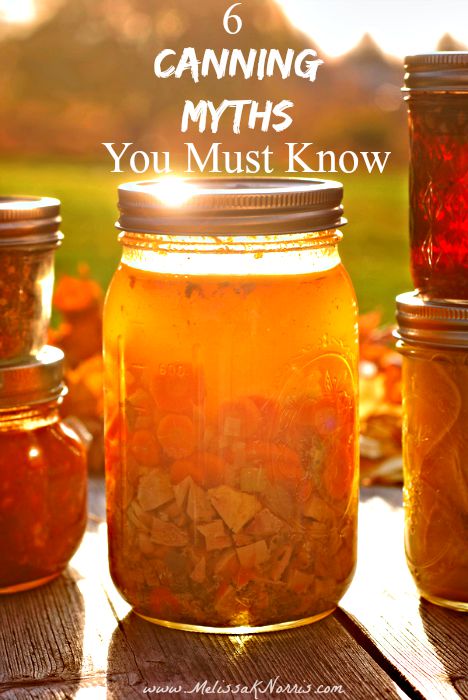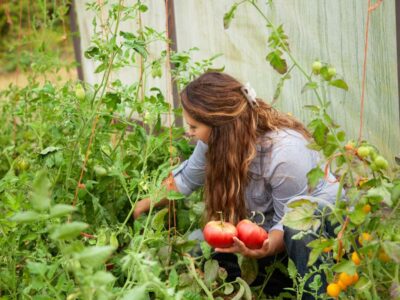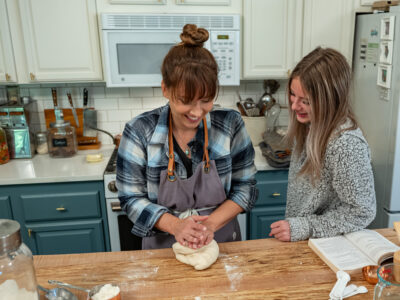Six canning myths you must know, because if you don’t, you run the real risk of making yourself or a family member very sick. I love canning, in fact, I may be addicted to stuffing food into Mason jars to line my home pantry shelves and food storage. But, there are some seriously dangerous practices going on in the canning world and we’re going to talk about them.

Tune in to the Pioneering Today Podcast where we have debunked common gardening myths and homesteading myths! I post new episodes every Friday morning. You can subscribe via RSS and receive every episode for free. ![]() Or subscribe via Itunes.
Or subscribe via Itunes.
Table of Contents[Hide][Show]
6 Canning Myths You Must Know
1. If it’s canned in the store you can “can” it at home. Nope. I wish this was true. I truly do, but commercial canners can reach much higher temperatures than our at home pressure canners, which means they are able to can things we can’t. Some examples, pumpkin butter and pumpkin pie filling. Just because it’s canned in the store doesn’t mean you’re safe to can it at home.
You’ll see store canned chicken noodle soup, but you can’t can this at home with the noodles in it. I have a complete post on how to alter your soup recipes to make them safe for home canning.
2. My grandmother and great-grandmother canned this way for years and they never got sick. You might be willing to gamble with your health and that of your loved ones, but I’m not. We know that botulism isn’t killed by the temperature of boiling water, which is 212 degrees Farenheit. Boiling food for longer doesn’t make it safe, even if you boil food for six hours, it still won’t reach above the temperature of the water, 212 degrees.
Botulism grows very well in an anaerobic environment (without the presence of oxygen, like sealed jars of canned food). It doesn’t grow in acid, so you may safely can acidic foods at home with a water bath, but for your vegetables and non-acidic foods, you must pressure can them.
Most people are canning food to be frugal, create healthier food than the grocery store, and to prepared for disaster. Let me tell you, a hospital visit isn’t cheap, becoming sick isn’t healthy, and preparing for a disaster while using means that could create one doesn’t make much sense to me. Botulism isn’t a form of food poisoning like the stomach flu. You can die from it. (Learn more about botulism prevention and preservation safety tips.)
I don’t tell you this to scare you. Canning food at home is completely safe, but you need to follow updated guidelines.
3. Oven canning is just fine, it’s the same temperature as boiling water after all. Oven canning is not a replacement for using a water bath. First, it’s a dry heat, and the glass canning jars aren’t made for dry heat, so you’re risking breaking your jars. Second, you don’t know that the internal heat of the food inside the jars is reaching a high enough temperature to kill off all the bacteria because dry heat is very slow to penetrate the jars and to sustain said heat long enough to kill the bacteria. Third, water bath and pressure canning help a jar vent, or simply put, it pulls out the oxygen from inside the jar. You’re not going to get this on a reliable level in an oven. They’re not designed for it.
Again, there’s lots of things I buck the rules on, but my family’s safety isn’t one of them. Use a water bath.
4. My jar sealed so I’m good to go. No. Sorry, just because your jar sealed doesn’t mean it’s safe. Some older recipes call for pouring your hot jam (or pickle brine) into the jar, putting on the lid and band, and turning it upside down to get a seal. You will get a seal in most cases, but generally the seal is weak and will come undone a few months into the jars shelf life. Most important, a seal in no way means there isn’t bacteria present, which is what the whole water bath and pressure canning process does.
I have to confess, when I first started pickling, I did this with some of my pickles in order to help keep them crunchy. I ended up losing almost every single jar because they came unsealed on the shelf, even though they’d initially sealed. Lesson learned. I’m thankful it wasn’t at the expense of my families health.
5. Just scrape the mold off of the jam/jelly and eat the rest. This used to be common practice, but once you see mold, even scraping off the top layer, the mold spores are already throughout your jam and jelly. We eat mold spores every day, little small ones we can’t see, and for most of us, it doesn’t cause any harm. But (you knew this was coming, right?) to someone with a compromised immune system, it can result in a fungal infection in the lungs. This is extremely hard to get rid of and to treat.
A better practice is to can your jam and jelly in smaller size jars. If it’s getting mold from being opened in the fridge too long, then simply can it in smaller jars.
If you see mold when you pull the jar off the shelf, then your seal was compromised and you should toss it out. The golden rule of canning is if in doubt, throw it out.
6. Canning is dangerous. Despite all these myths, canning is safe if you follow the guidelines and stay up to date with your practices. I’ve eaten home canned food my entire life and canned on my own for over 16 years. We’ve never gotten sick, ever. I want to reassure you again, canning is easy and fun, just follow the “rules”. Canning isn’t the place to be a rebel.
Home canned food is often much more nutritious than store bought canned goods. One, most home canned food is canned from produce picked from the vine and processed almost immediately. Your home canned jams and jellies don’t contain food dye, high fructose corn syrup, or other GMO additives, and usually, they have less sugar. Especially if you’re using my low sugar recipes.



